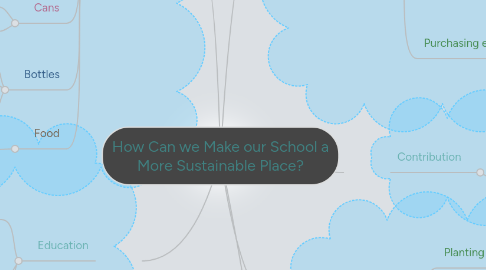
1. Recycling
1.1. Wood
1.1.1. Can be put in the composter
1.1.2. Used as fuel
1.1.3. Used as a source of bioenergy
1.2. Paper
1.2.1. Can be sent to a recycling plant
1.2.2. Use the paper as much as possible
1.2.2.1. Use both sides
1.2.2.2. Make the printing size of documents smaller, so more copies can fit on one page
1.2.3. Recycle paper at school
1.2.3.1. Art projects
1.2.3.2. Composter
1.3. Cans
1.3.1. Send cans to a local recycling plant
1.3.2. Save cans for art or D.T projects
1.4. Bottles
1.4.1. Send them to a recycling plant
1.4.2. Clean and reuse them
1.4.3. Encourage students to bring their own bottles to school.
1.5. Food
1.5.1. Place all left over food into the school's composter.
2. Renewable Energy
2.1. Solar
2.1.1. Solar Panels
2.2. Wind
2.2.1. Wind Turbins
2.3. Bioenergy
2.3.1. Recycling Station for wood
2.3.2. Composter
3. Education
3.1. Create a programme that educates students about the importance of a sustainable school.
3.2. Incorporate things like, solar panels and the composter into subjects such as science and maths.
3.3. Create a live ecosystem for students to study
3.3.1. Fish
3.3.2. Tadpoles
4. Conservation
4.1. Using Less Paper
4.1.1. Become stricter on recycling paper at school.
4.1.2. Distribute paper recycling bins to each class room; label them clearly.
4.1.3. Send paper to a local recycling plant.
4.1.3.1. Any earned money can be put towards other environmentally associated projects.
4.2. Wasting Less Food
4.2.1. Make sure the catering company makes just enough food for students.
4.2.1.1. Take orders every morning, so the staff know how many orders of each meal to make.
4.2.2. Use a composter to recycle left over food.
4.3. Using Less Electricity
4.3.1. Making sure all lights and other electronic devices are turned off after school hours.
4.3.1.1. Connecting sensors to the devices so that they turn off automatically at a specific time.
4.3.2. Make sure lights are off in empty classrooms.
4.3.3. Use energy efficient light bulbs.
4.4. Purchasing excess food
4.4.1. Find out how much food the school requires on average, per week.
4.4.2. Make a small veggie patch; use grown vegetables for school meals.
5. Environment
5.1. Planting more trees in the school environment
5.1.1. Creating small gardens
5.2. Making sure the school is tidy; litter free
5.2.1. Purchase more rubbish bins; distribute them around the school evenly
5.2.2. Have groups of students go out and clean up the litter and tend to the gardens at allocated times.
6. Contribution
6.1. Enrolling the school in environmentally related projects.
6.1.1. Global Classroom: Challenged Based Learning.
